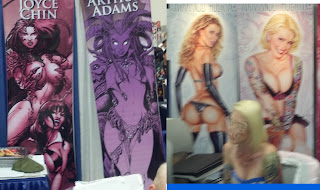- How much information needs to be included in the picture and what should be left out ?
- How large should an element be in relation to other elements?
- What colors give it the proper emphasis?
- How much detail should it have, before detail starts to become counterproductive?
These choices about information establish the artist's priorities; they are at the heart of what makes art great and important. They affect not just the content but the timing of art's revelations-- the strategic places where art pauses as it lifts its petticoats.
But in our era of information technology, "information" has been radically redefined, and consequently so has the artist's struggle to manage information with taste and style.
The ability to evaluate -- "assign value to"-- information may be the central identity crisis for art in our time. Technology enables us to automate information management with search engines, data mining and similar tools. (For example, it would be impossible for you to make sense of those 120 cable TV channels without the software to scan and make those channels comprehensible.) But so far such tools provide little assistance for the kind of meaningful evaluation traditionally performed by artists.
Andy Warhol recognized very early that the mind of the artist would be outmatched by our new ability to gather information. He abdicated the artist's editorial role in films such as Sleep which simply recorded a man sleeping for 40 minutes. By turning the camera on and collecting information unfiltered by human taste, Warhol showed the muscularity of technology when it comes to capturing raw data. But in the long term that revelation does not help us isolate the elements that are worth saving and thinking about.
Since Warhol's day, the ratio of information to idea has become increasingly anemic. Live video captures and video installations drone on indiscriminately in the world of fine art. Digital installations create immersive environments and even virtual realms but they are adrift. In the words of Karrie Jacobs, "With information technology our reach is infinite but our grasp is weak."
Which brings me to ComicCon, the real subject of today's post.
Each year when I return to ComicCon, I am impressed with the progress that picture making and story telling have made in moving into the digital space. I attend a dozen programs with titles such as "Reinventing the Graphic Novel for the Ipad" or "New Methods in Digital Painting" or "The Future of Graphic Novels." At these programs, talented and energetic entrepreneurs out to make a buck describe their latest innovations in curating the vast sea of information. They talk about "the heritage of story telling colliding with the digital space," and look for solutions that "celebrate the valuable and the good in digital" while avoiding the vast quantities of "disposable junk" which has no human or commercial value.
Sometimes the images from these projects are weak, often photoshopped from photographs, but these creators have at least made a good start; they have learned to employ apps to make a monster in the background of one panel get up and crawl out of the panel and across the page of your e-book. They have wrestled earnestly to find the best way to support a drawing with a historical film clip, and unlike Andy Warhol, they fight to remain in artistic control of the technology: "Even though it would be easy to incorporate a whole Wikipedia article at this point, we want just the right amount of content, and in the right form, to make the reader curious" and enhance the story.
Good ol' commercial art.
When "gallery" art becomes overwhelmed and superfluous and decadent, art in the service of robust commerce retains its center of gravity. It has an economic incentive (which "art for art's sake" lacks) to put up a good fight to keep information relevant and comprehensible.
For me, art has greater value when it is integrated into life, in the service of the story or the hunt or the sacred, or even just decorating our environment with folk art the same way the bower bird decorates its nest. Commercial art tortures artists with the need for prioritization, but there seems to be no better antidote to the self-indulgence and pretentiousness that have robbed gallery art of the critical faculties necessary to make important judgments about digital information.
Obligatory Picture
Since this blog is all about pictures, any of you who have plowed through all this verbage deserve at least one picture. Here is what appears to be an insightful bit of social commentary from your old friends at Playboy Magazine: as I left my hotel one morning, I discovered that Playboy had sent "bunny Avengers" to ComicCon. They were assembling in the hotel lobby; if you look closely, you'll see "bunny Hulk," "bunny Thor," "bunny Captain America," etc.
What could possibly be cooler than that?


























